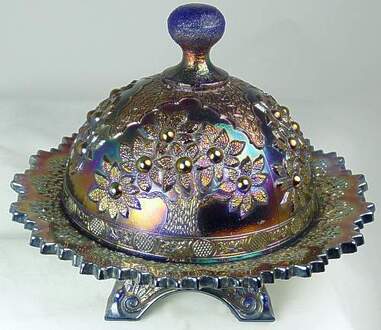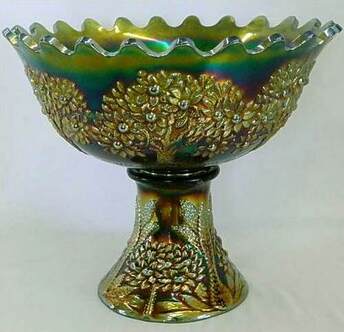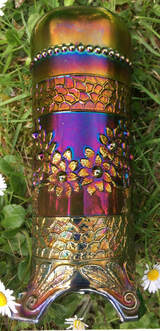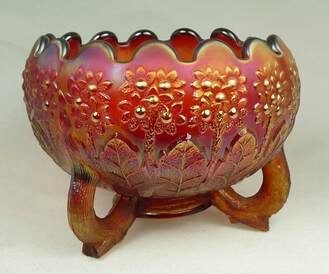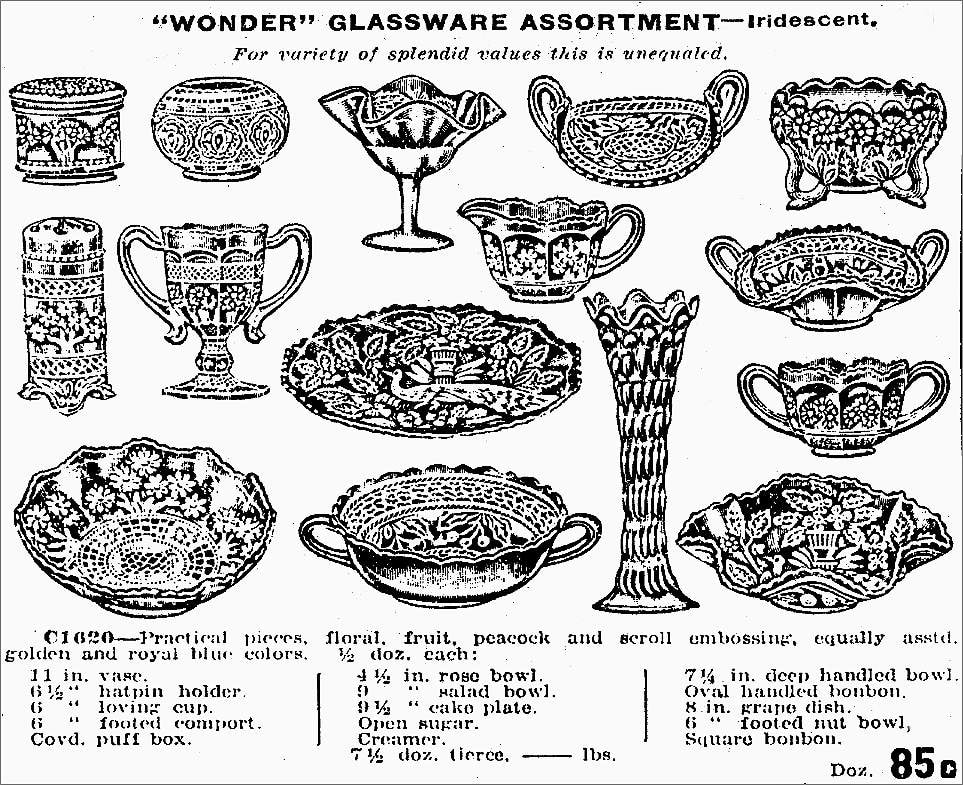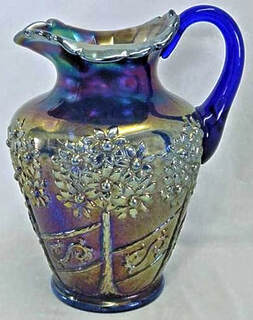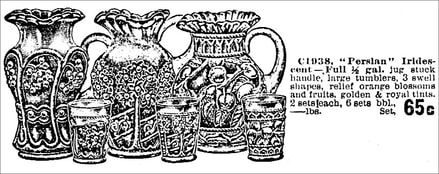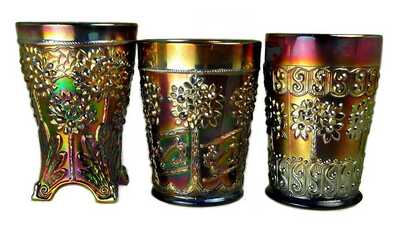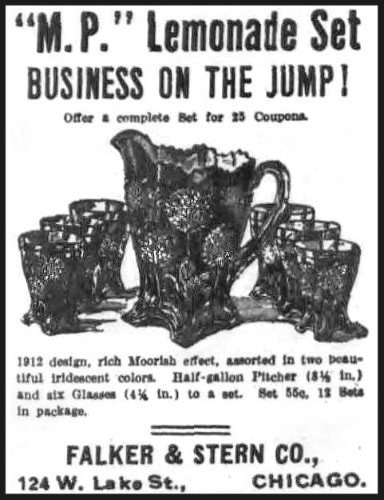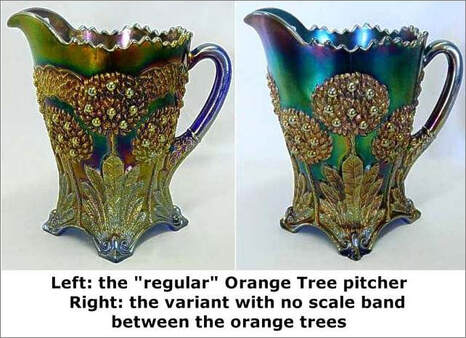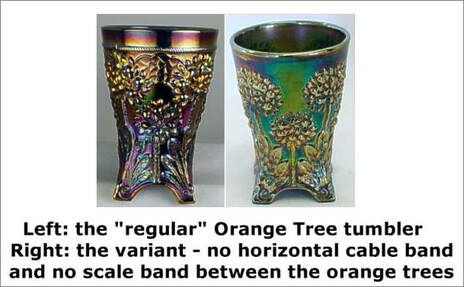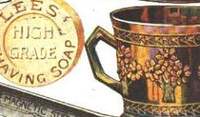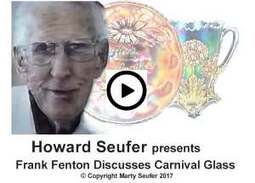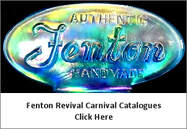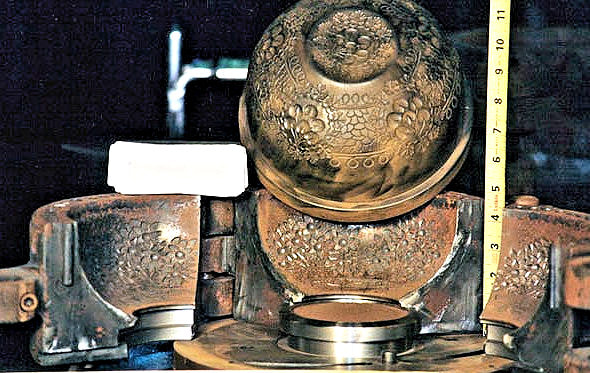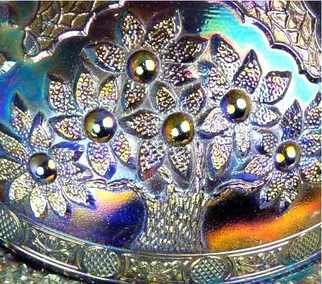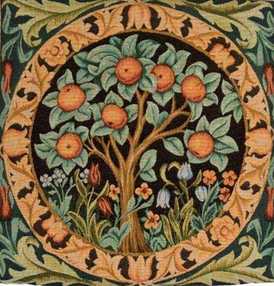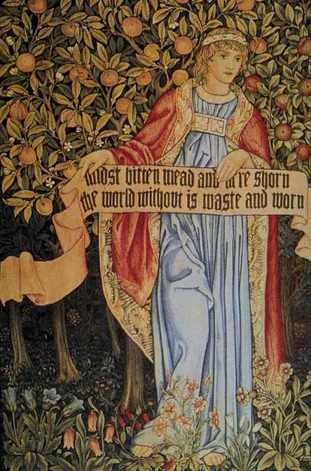Orange Tree - The Story Behind The Glass
G&ST, November 2015. Updated 2018, 2019 and 2024
In the language of flowers, the orange tree stands for sweetness and generosity. It is one of the most prolific trees and is an ancient symbol of fertility and love. The British designer, William Morris, and many of his contemporaries, produced a rich variety of popular patterns that featured the orange tree in the late 1800s and early 1900s. The symbolism of the tree and its fruits and flowers was not lost on these designers, many of whose patterns bear an amazing resemblance to the later Orange Tree Carnival designs that were clearly reflecting popular taste.
The Orange Tree pattern in Carnival Glass - a Fenton speciality.
|
In their familiar and ever popular “regular” Orange Tree pattern, Fenton produced a wide range of shapes and colours, as well as vagaries within the design (such as flower border or tree trunk variations). Table sets, water sets, punch sets, dressing table sets, plates, wines, mugs, loving cups and a truly splendid variety of bowls were made in the Orange Tree design. The Orange Tree pattern appeared in the April 1912 issue of the Butler Brothers wholesale catalogue, as shown on the left. Shapes in the pattern included the lidded powder bowl / "puff box", footed rose bowl (which, confusingly has also been given the alternative name of Fenton's Flowers), hatpin holder, handled loving cup, sugar, creamer and collar-base 9" bowl. Elsewhere in the same catalogue there is the footed sauce / sherbet ("jelly"). The Orange Tree mug appears in the April 1913 catalogue, as does the scroll-footed fruit bowl with Orange Tree being both the interior and exterior pattern. Orange Tree footed rosebowl in red (sometimes referred to as "Fenton's Flowers" pattern, but it is Orange Tree).
|
Butler Brothers wholesale catalogue, April 1912.
Orange Tree had a long production run, and was still being shown in Butler Brothers in the late 1920s, although by that time, only the 9" collar-base bowl and the mug was being advertised. Perhaps unsurprisingly given its long production period, some 20 different Carnival colours are reported for this pattern. The later Classic Carnival colours of red / amberina and celeste blue are also found, but only in a very restricted shapes, which probably reflects how the range of shapes being made was gradually reduced through the 1920s. |
|
As well as the "regular" Orange Tree pattern that was made in so many different shapes, Fenton made two different patterns that used the orange tree motif: Orange Tree Scroll and Orange Tree Orchard, both of which were made only in water sets (blow-moulded pitcher with an applied handle, and tumbler).
Orange Tree Orchard pitcher, blue. Seeck Auctions.
On the right are the three Fenton tumblers that adopted an orange tree motif; common to all three of them is the tree motif, with the oranges surrounded by clusters of stylised leaves giving the appearance of large, daisy-like flowers or rosettes. |
An Orange Tree Orchard pitcher was offered in Butler Brothers in 1912, as part of a trio of Fenton water sets. The others are Blueberry (left) and Apple Tree (right).
Above, left to right: Orange Tree (footed), Orange Tree Orchard,
Orange Tree Scroll tumblers, all blue. |
|
There is also an early variant in the design of the "regular" Orange Tree pitcher and tumbler. In NetworK #34 (March 2018), we showed this ad (right) that we discovered in a 1912 edition of "The Billboard", and which offered this early variant. Although the image is rather dark, you can see the difference between the variant and the "regular" pattern. For clarity, here are two images to show it very clearly. Extract from a 1912 edition of "The Billboard".
|
The variant is rare, because Fenton had to re-work the mould to overcome a technical problem with using it in production. The problem was explained clearly by the late Frank Fenton in a video filmed by the late Howard Seufer. It is one of a series of Howard's wonderful videos that we are proud to host here on our website. Click here: "Howard Seufer Presents" or click on the image on the right to see the complete series.
|
Orange Tree was clearly a popular Classic Carnival seller for Fenton. We found it available by Mail Order in both the Lee Manufacturing and the Perry G Mason Mail catalogues. Click on either image below to see these wonderful Mail Order catalogues in our unique "Sell it to me!" feature. |
Orange Tree revived!
|
The concluding chapter of the Orange Tree story was when Fenton decided that it was to be one of their Classic Carnival patterns that was going to be reissued in Revival Carnival Glass. Orange Tree was included in two of their earliest reissues; a bowl in two shapes had an Orange Tree exterior pattern teamed up with a Cherry Chain interior (another classic pattern) in Fenton's 1972 catalogue, where it was re-named "Orange Tree and Cherry", and the footed rosebowl featured in the 1973 "Fenton Orange Carnival" catalogue, where it too was re-named as "Leaf and Orange Tree". Other Revival Carnival colours followed in subsequent years. |
Here are the Fenton moulds that were used for Revival Carnival pieces.
Above is the Cherry Circles plunger / Orange Tree exterior mould combination for "Orange Tree and Cherry". On the left is the mould for "Leaf and Orange Tree" - given its clean, shiny appearance, it actually looks as though it was a newly made mould for Revival Carnival. It was also used with an interior "Lions" pattern. Images of the Fenton moulds are courtesy of Fenton Art Glass Company and the Fenton Family. |
The Story Behind the Glass is crystal clear. The orange tree motif on Carnival Glass was undoubtedly influenced and inspired by popular contemporary designs on fabrics and wallpapers. William Morris (renowned designer and founder of Morris & Co.) created the “Woodpecker” tapestry in 1885, with its delightful orange tree feature. A similar orange tree motif was used as a feature on several other works by Morris & Co., notably the “Orchard” wallpaper (1899) attributed to Morris’s chief designer J. H. Dearle. Carpets, fabrics, tapestries as well wallpapers featured these and similar designs that were clearly the inspirations behind Fenton’s splendid Orange Tree patterns.
The Story Behind the Glass is crystal clear. The orange tree motif on Carnival Glass was undoubtedly influenced and inspired by popular contemporary designs on fabrics and wallpapers. William Morris (renowned designer and founder of Morris & Co.) created the “Woodpecker” tapestry in 1885, with its delightful orange tree feature. A similar orange tree motif was used as a feature on several other works by Morris & Co., notably the “Orchard” wallpaper (1899) attributed to Morris’s chief designer J. H. Dearle. Carpets, fabrics, tapestries as well wallpapers featured these and similar designs that were clearly the inspirations behind Fenton’s splendid Orange Tree patterns.
Above: the design inspiration is clear to see! On the left is a detail from Fenton's Orange Tree butter dish lid,
and on the right is William Morris' design of the late 1800s. Note how the Fenton design version even incorporates
an encircling border, much like the one in the Morris Orange Tree tapestry detail (source: Public Domain).
and on the right is William Morris' design of the late 1800s. Note how the Fenton design version even incorporates
an encircling border, much like the one in the Morris Orange Tree tapestry detail (source: Public Domain).
|
Above, left: "Summer", a detail from a tapestry called "The Seasons" or "Orchard," woven by Morris and Company in wool, silk, and mohair on a cotton ground at Merton Abbey in 1890, designed by William Morris and John Henry Dearle. (Details from Linda Parry, William Morris Textiles.)
Above, right: a detail of the Woodpecker tapestry designed by William Morris. 1885. Public Domain. |
Footnote: Good design never wanes. The popularity of the Orange Tree designs continues today, and can be found on cushion covers, wrapping paper, diaries, aprons, fabrics, scarves and so much more.
Read more of The Stories Behind the Glass in Carnival Glass Times
Read more of The Stories Behind the Glass in Carnival Glass Times
